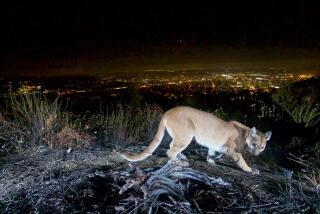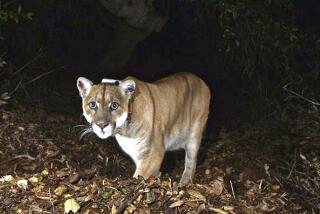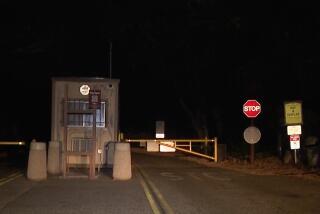New Threats From Coyotes Result in Closure of Park
National Park Service officials ordered 2,100-acre Cheeseboro Canyon Park in Agoura Hills closed Tuesday after horseback riders reported they were chased Monday evening by a pack of three “extremely aggressive coyotes.”
The incident occurred two days after another horseback rider said he was attacked by a similar band of animals.
Incident Reported
After announcing the closure, park officials learned of yet another incident involving a pack of three coyotes that a local resident said chased him and his wife down a hillside in the area.
Park rangers posted signs Tuesday prohibiting entrance to the canyon, closing off the popular, rustic nature preserve to about 200 weekly visitors who ride horses and hike on eight miles of trails.
It was the first time the park has been closed since the Park Service took over in 1978 with the creation of the Santa Monica Mountains National Recreation Area, a spokesman said.
“Until we are sure that there is no unreasonable danger to the public, the park will remain closed,” said Daniel Kuehn, superintendent of the recreation area.
Armed rangers on horseback set out at dusk Tuesday, the approximate time of the attacks, to survey a half-mile area of the canyon where both reported coyote incidents occurred, said Phillip Young, supervising park ranger. The rangers were under orders to shoot any coyotes that attacked or displayed aggressive behavior, he said. However, the rangers returned without encountering any coyotes.
The park will remained closed on a day-to-day basis, , Young said.
In the first and most serious incident, Michael Rizzo, 42, of Agoura reported that he was attacked by three coyotes at about 8 p.m. Saturday while riding his horse in a remote canyon area. Rizzo suffered two puncture wounds and scratches on his right arm and is undergoing a series of anti-rabies inoculations. The animals also nipped and scratched the legs of Rizzo’s horse.
On Monday night, an Agoura Hills couple who were riding in the same area at about the same time reported that they were chased for more than a mile by three coyotes.
“They were at full gallop for more than a mile, shouting, trying to scare the coyotes off,” Young said.
The ranger said the animals backed off about half a mile from the canyon’s entrance, near several houses. The riders were not hurt.
Not an Isolated Incident
“We were hoping the first report was an isolated aberration and would not happen again,” Kuehn said, “but with this second report in the same place, we believe we have a problem out there.”
Park officials and animal experts were at a loss Tuesday to explain the vicious behavior of the animals and speculated that they may be wild dogs that look like coyotes.
By nature, coyotes attack small animals such as squirrels and rabbits. Also, coyotes usually hunt alone, said Eric Hughes, a veterinarian with the Los Angeles County Department of Animal Care and Control.
“Coyotes normally do not go into settings that are potentially dangerous and never go after anything that is larger than themselves,” Hughes said. “From what I can see, these seem to act more like feral dogs.”
Even If Rabid
Hughes said that even a rabid coyote would not normally travel in a pack, because the disease would tend to cause it to fight with others of its kind.
During a press conference at the park announcing the closure, three stray dogs ran out from the undergrowth and brushed against rangers and reporters, prompting Young to issue a warning to residents and visitors not to feed animals. He said hungry stray or wild animals can turn against the hands that feed them.
After the press conference, Harry Jones, a 12-year resident of the area, approached Young to report that he too had been chased by coyotes recently.
Jones, 56, said in an interview that he and his wife were walking their dog at dusk Friday when they spotted three coyotes about 100 yards away.
“Those coyotes saw us and came after us like gang busters. They went crazy,” Jones said.
He said he and his wife ran down the hill and that the animals came within 25 yards of them before turning away.
“Believe me, I love this area and consider it my backyard,” Jones said. “But I’m not going back up there until those coyotes are gone.”
More to Read
Sign up for Essential California
The most important California stories and recommendations in your inbox every morning.
You may occasionally receive promotional content from the Los Angeles Times.










